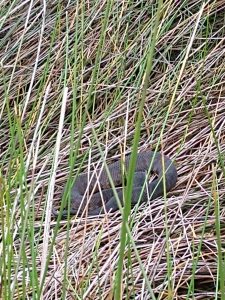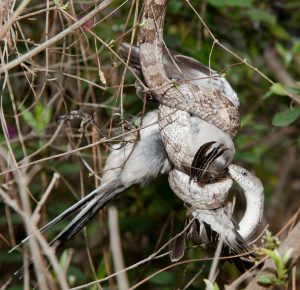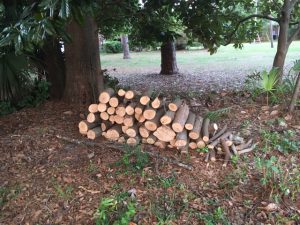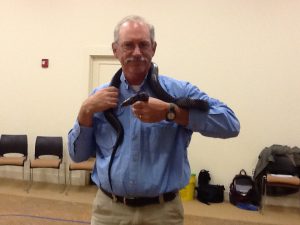The subject for today’s wildlife lesson is one that, actually, hope you do not find – but you might.
The reason for selecting this one today is because I have been getting a lot of emails about them in the last few weeks. Seems as humans stay closer to home, these creatures become more visible in locations we are not frequenting. I am talking about snakes.

Photo: Nick Baldwin.
I have lived in my current house for over 30 years and have only seen one snake – and I do a lot of exploring in our yard. Most species do not like to be around us. One snake researcher who has radio tagged them says, they are more common than we might think – they are just really good at concealing themselves, much like coyotes.
That said, I have had a lot of emails in the last few weeks wanting to identify snakes they are seeing. I think most of these encounters were due to the lack of rain. Snakes, like all animals, need water. In drought situations they will risk human encounters to find it. With recent rains, these encounters should decrease.
But I also know that when humans stop visiting certain locations (state and national parks for example) snakes relax and move about a lot more. We saw this after Hurricane Ivan in 2004. The road to Ft. Pickens was washed away, there was no way to reach the fort other than walking or boating. Human chaos and commotion were reduced to almost nothing – and wildlife emerged. I know encounters with snakes was very common for the first few weeks after people re-entered the park. First on foot and bike, then by car, and over time wildlife (including snakes) went back into hiding.

Photo: Jenn Archer
In my neighborhood there is much more outdoor human activity than there was before the COVID-19 restrictions – the chance of encountering “wandering wildlife” is probably lower here now than before the pandemic occurred. But people will venture out into parks eventually. I am already seeing more cars and less walkers now. So MAYBE an encounter will occur. As I said, I have had a lot of emails wanting to identify encounters now. So, let’s talk about snakes some in case you do find one.
First, they are animals – just like us and your dog – except they do not have feet – and that is weird. As animals they have some basic needs – food, water, and shelter. They are carnivores, hunting a variety of prey that they can grasp with their teeth and swallow whole. They do not have molars and cannot chew. Not having hands, they cannot grab their prey with claws but rather grab them with their teeth and hold on.
Some will coil over their prey and once they have it, they constrict each time the prey inhales until the prey suffocates – we call these constrictors. One research paper suggested the prey may actually die of a heart attack before suffocation – maybe, I can see that. Others do not constrictor but rather just consume their prey whole. Obviously, they must select a prey they can do this with. And for a few, very few, they inject a venom that paralyzes the prey and begins digestion before the snake begins to swallow it. You can see why a snake would think this is a cool way to eat. Fighting a prey and holding on for dear life is much harder than striking it, letting it die, and then eating it. But there are very few local snakes that do this. Of the 46 species of snakes known in Florida, only 6 of them are venomous (13%).

Photo: Nick Baldwin
That means 87% are nonvenomous, but I think the main reason 99% of humans who encounter snakes are terrified beyond their wits is because they are afraid of a venomous bite. Maybe they are just afraid of a bite, but I know the fear of these things is very real and, with some humans, very deep. I have done enough snake education programs to see how some folks react when the see a live snake. They are very very nervous. This is why I hope you DO NOT see one exploring in your yard. They are very scary for many people.
So where would I find one in my yard? And what should I do when I see one?
As we mentioned above, the only reason they would enter your yard is for a resource they need: food, water, or shelter. Because they must grasp and swallow their prey whole, you are not prey – but rodents and frogs are. Some snakes eat insects or baby birds, and lizards. Some snakes eat other snakes. But you and your pets are danger and they want to avoid you. There are probably places where their prey hides and snakes COULD be found hiding there as well.

A water source, such as a pond, creek, or sometimes even swimming pools, will attract them. And then, there is shelter. It is spring, mommy snakes are looking for hiding places to lay their eggs or give live birth (as some snakes do). You may have a location in your yard they would like. But keep in mind, they do not like people and would do this only because they have no better options. Habitat loss can cause increase in snake encounters.
If you find one, again the chance is very low, what should I do?
Well… I have observed most wildlife display a sequence of defensive behaviors when they encounter potential trouble – which a snake seeing us would think. I call them the 3 “F’s”.

Photo: Rick O’Connor
First, they “freeze” – as we do when we see the snake. It is startled – you are startled. If you are walking through the yard and the snake senses you it will freeze – just lie low and hope you go on by. Again, one research has suggested that these sorts of encounters probably happen more often than would like to know.
Once you have detected each other – the second behavior would be to “fly” – escape. Snakes will be looking for an exit plan – give them one. Chances are you are screaming running the other way already, but do not block any exit plans for the snake because if there are none – they will go to the third “F” which is “fight”. They may hiss, rattle their tail (many snakes, not just rattlesnakes, do this), open their mouth wide, some may even strike. They are letting you know you are too close. Again, back away and allow the snake to escape.
I will tell you this, 95% of the people bitten by snakes in the U.S. are either trying to catch it or kill it. So, attempting to do one of those two will increase your chance of getting bit. Just allow it to leave your yard. I will also tell you that some are bitten because they did not know the snake was there. They turned over a pot, or log, not knowing. This is not common but does happen.

Again, I have lived in this house over 30 years, have explored our yard with my grandson a lot, and have only seen one snake in that whole time. It was the Southern Black Racer – every common nonvenomous snake in yards. I would imagine that if you have been doing these outside activities I have been posting, you would have seen one by now if you had them lurking somewhere. That said, I have had an increase in snake encounter emails recently and thought – with the changing times – that a quick lesson on this might be a good idea.
ACTIVITY
– Today let’s just explore places where any wildlife might be hiding. Do this with your parents and use a rake or shovel to turn things over – just in case – and to confirm. My hunch is that very few of you will find a snake. But you may find other cool things.
– Lizard and butterfly encounters are on the rise at our house right now. We are not sure, but we think the brown anole may attack and consume monarchs as they emerge – someone did, and the monarchs are supposed to have a bit of poison in them from eating the milkweed, but someone did. That’s something I will watching today.
GO OUTSIDE – STAY SAFE AND HAVE FUN
 0
0
